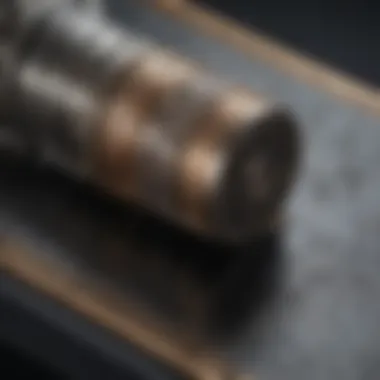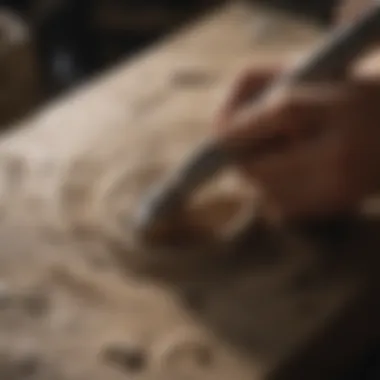Unlocking the Essentials of Dremel Tool Usage for Novice Users


Rock and Fossil Identification
In the realm of utilizing a Dremel tool for beginners, understanding the identification of rocks and fossils holds paramount importance. As novices venture into this versatile world, recognizing the various types of rocks and fossils becomes essential. Differentiating between sedimentary, metamorphic, and igneous rocks, as well as distinguishing between plant and animal fossils, sets the foundation for fruitful exploration. Beginners must focus on key characteristics like color, texture, and structure to facilitate accurate identification. Utilizing tools like magnifying glasses and specialized identification kits further enhances the precision of this process.
Collecting Tips and Techniques
For beginners embarking on the journey of using a Dremel tool, mastering the art of collecting rocks and fossils is a pivotal aspect. Adopting best practices such as obtaining permission before collecting, respecting the environment, and preserving the natural landscape is crucial. Identifying prime collecting sites through research and networking with experienced collectors unveils opportunities for fulfilling discoveries. Safely extracting specimens without causing damage requires finesse and attention to detail. Employing tools like chisels, brushes, and protective gear ensures a successful and safe collection expedition.
Preservation and Display
Preserving the integrity of collected rocks and fossils is a crucial step in the utilization of a Dremel tool for beginners. Implementing techniques such as cleaning with gentle brushes, stabilizing fragile specimens, and utilizing proper storage containers safeguards the longevity of the collection. Employing moisture-control methods and avoiding direct sunlight preserves the authenticity and beauty of rocks and fossils. When it comes to displaying these precious finds, creativity plays a key role. Incorporating shadow boxes, mounting specimens on stands, or creating themed exhibits adds aesthetic value to collections and showcases the beauty of nature.
Geological Insights
Delving deeper into the realm of using a Dremel tool unveils fascinating geological insights for beginners. Exploring the formations and processes that shaped rocks and fossils over millions of years offers a profound appreciation for Earth's history. Understanding the historical significance of certain rocks and fossils provides context to their origin and evolution. Learning about notable discoveries in the field, such as rare fossils or unique geological features, sparks curiosity and invites further exploration into the rich tapestry of Earth's geological past.
Introduction to Dremel Tools
In the vast world of craftsmanship and DIY projects, the prominence of Dremel tools stands tall. The significance of grasping the essence of Introduction to Dremel Tools cannot be overstated for beginners venturing into this domain. Understanding the core principles and functionalities of a Dremel tool sets the foundation for embarking on a journey towards mastering its diverse applications and techniques. Delving into the realm of Dremel tools offers individuals a gateway to precision, versatility, and creativity in their projects. By comprehensively immersing oneself in the basics of Dremel tools, beginners pave the way for seamless progression and honing of their crafting skills.


What is a Dremel Tool?
At the core of any discussion surrounding Dremel tools lies the fundamental question - what exactly is a Dremel tool? In essence, a Dremel tool is a versatile handheld rotary tool renowned for its precision and adaptability across various materials. From woodworking to metalworking, crafting to intricate detailing, a Dremel tool serves as a multifunctional powerhouse in the toolkit of artisans and DIY enthusiasts. Its ergonomic design, coupled with interchangeable accessories and attachments, empowers users to undertake a myriad of tasks with finesse and accuracy. Mastering the intricacies of a Dremel tool involves acquainting oneself with its components, functionalities, and the vast possibilities it offers in the realm of creativity and craftsmanship.
History and Evolution of Dremel Tools
To grasp the true essence of Dremel tools, one must delve into their rich history and evolutionary journey. Originating from the vision of Albert J. Dremel, these tools have undergone a transformative evolution since their inception. From simple rotary tools to complex, high-performance devices, the journey of Dremel tools reflects the relentless pursuit of innovation and quality. Understanding the historical backdrop and technological advancements of Dremel tools not only showcases their legacy but also sheds light on the progressive nature of craftsmanship and tool design. As beginners delve into the world of Dremel tools, recognizing their evolution becomes instrumental in appreciating the capabilities and possibilities these tools bring to the table.
Types and Varieties of Dremel Tools
Dremel tools come in a diverse array of types and varieties, each tailored to cater to specific tasks and user preferences. From corded to cordless models, compact to heavy-duty variants, the market offers a plethora of options for individuals to choose from based on their requirements. Understanding the different types of Dremel tools allows beginners to select the most suitable option that aligns with their projects and skill level. Factors such as speed settings, power sources, and ergonomic features play a crucial role in determining the ideal Dremel tool for a given task. By exploring the varied types and varieties available, beginners can make informed decisions and embark on their Dremel tool journey with confidence.
Getting Started with Your Dremel Tool
In the realm of utilizing a Dremel tool, initiating the journey correctly is paramount. Ensuring that novices grasp the essential foundations of commencing their experience with this versatile tool is key to their success. This section serves as a gateway to the world of Dremel tools, as it lays down the groundwork for all ensuing endeavors. Understanding the significance of Getting Started with Your Dremel Tool is crucial as it sets the tone for proficiency and safety in all future applications.
Setting Up Your Dremel Tool
When delving into the intricacies of using a Dremel tool, the process of setting it up appropriately cannot be overlooked. This facet directly impacts the tool's functionality and the user's overall experience. By comprehensively detailing how to set up a Dremel tool, beginners can navigate through the initial stages with ease and confidence. From assembling various components to adjusting settings, each step in the setup procedure is meticulously outlined to ensure a seamless transition into using the tool effectively.


Understanding Dremel Accessories
An integral part of maximizing the potential of a Dremel tool lies in understanding its diverse range of accessories. Each accessory serves a specific purpose, enhancing the tool's capabilities for various applications. Shedding light on the multitude of accessories available, this section provides insights into the functionality and compatibility of different attachments with the Dremel tool. By delving into the intricacies of each accessory, novices can make informed decisions about which attachments align best with their intended tasks.
Safety Precautions and Gear
Prioritizing safety when utilizing a Dremel tool is non-negotiable. This section emphasizes the importance of incorporating safety precautions and gear into every aspect of using the tool. From protective eyewear to suitable clothing, each safety measure is designed to safeguard the user from potential hazards. By instilling a safety-first mindset, beginners can confidently explore the capabilities of a Dremel tool while minimizing risks. Understanding the significance of safety precautions and gear is fundamental to ensuring a secure and productive user experience.
Basic Techniques and Applications
Grinding and Sanding
Grinding and sanding are essential techniques when using a Dremel tool, serving crucial roles in refining surfaces, shaping materials, and achieving desired smoothness or texture. Grinding involves the removal of excess material, while sanding helps to smoothen rough edges and surfaces. Beginners should carefully select appropriate grinding and sanding accessories based on the material and desired outcome to ensure effective results. Understanding the proper techniques for grinding and sanding is vital to avoid damage to both the workpiece and the tool.
Cutting and Carving
Cutting and carving with a Dremel tool open up a world of creative possibilities for beginners. These techniques allow for precise shaping, sculpting, and customization of various materials such as wood, plastic, and metal. Aspiring enthusiasts can explore different cutting and carving accessories, each designed for specific applications and detailing tasks. Mastery of cutting and carving techniques not only enhances craftsmanship but also enables individuals to unleash their artistic expression through intricate designs and modifications.
Polishing and Cleaning


Polishing and cleaning with a Dremel tool add the finishing touches to projects, refining surfaces and restoring materials to their original shine. Polishing enhances the aesthetic appeal of objects by creating a smooth and reflective surface, while cleaning removes dirt, grime, and rust, revitalizing the appearance of items. Beginners should familiarize themselves with various polishing and cleaning attachments, along with suitable techniques to achieve optimal results without causing damage. Prioritizing proper polishing and cleaning practices maintains the quality and longevity of finished projects, showcasing attention to detail and precision.
Advanced Tips and Techniques
In our exploration of the basics of using a Dremel tool for beginners, delving into advanced tips and techniques is crucial for expanding one's skills and capabilities with this versatile tool. Understanding the nuances of advanced techniques elevates the user's proficiency and opens up a diverse range of creative applications. By honing these techniques, users can achieve finer detail and precision in their projects, pushing the boundaries of what they can accomplish.
Diving deeper into engraving and etching with a Dremel tool unveils a world of artistic possibilities. Engraving involves using specialized attachments to carve intricate designs into various materials, adding a personalized touch to projects. Etching, on the other hand, focuses on creating shallow imprints or designs on surfaces, providing a unique way to embellish items like glass or metal. Mastering these techniques requires patience and practice but unlocks endless creative avenues for aspiring artisans.
When it comes to drilling and routing with a Dremel tool, precision is key. The ability to drill small, precise holes in different materials allows for intricate detailing and customized designs. Routing, on the other hand, involves creating channels or grooves in surfaces, ideal for woodworking or crafting tasks. Understanding the proper techniques and tool attachments for drilling and routing enhances efficiency and accuracy in various projects, making them more professional and polished.
Accessory compatibility and upgrades play a significant role in maximizing the utility of a Dremel tool. Ensuring that accessories are compatible with the specific model of the tool guarantees seamless operation and optimal performance. Upgrading to high-quality accessories can enhance precision, speed, and overall output quality. By investing in compatible accessories and exploring upgrades, users can expand the versatility of their Dremel tool, taking their craftsmanship to new heights.
Maintenance and Care for Your Dremel Tool
Maintenance and care for your Dremel tool are pivotal aspects to ensure its longevity and optimal performance. In the realm of Dremel tools, meticulous attention to maintenance safeguards against wear and tear, extending the lifespan of the tool. Additionally, proper care enhances the safety of operation, reducing the risk of malfunctions or accidents significantly. Understanding the significance of maintenance and care contributes to a seamless and efficient experience with your Dremel tool.
Cleaning and Lubricating Your Dremel
When it comes to cleaning and lubricating your Dremel tool, precision is key. Accumulated debris or dust can hinder the functionality of the tool, emphasizing the necessity of regular cleaning. Utilizing appropriate cleaning tools and methods tailored to the intricacies of the Dremel ensures thorough removal of contaminants. Additionally, lubrication plays a vital role in maintaining the smooth operation of the tool, preventing friction-induced damage and promoting longevity. By adhering to a consistent cleaning and lubrication routine, you uphold the performance and durability of your Dremel tool.
Storage and Handling Tips
Efficient storage and proper handling practices are paramount in preserving the condition of your Dremel tool. Shielding the tool from environmental factors such as moisture or extreme temperatures safeguards its components from corrosion or deterioration. Implementing designated storage solutions, like cases or organizer boxes, enhances organization and minimizes the risk of damage or misplacement. Furthermore, adopting secure handling techniques when operating or transporting the Dremel ensures stability and reduces the likelihood of accidents. By integrating strategic storage and handling approaches, you safeguard the integrity and functionality of your Dremel tool.
Troubleshooting Common Issues
In the course of using a Dremel tool, encountering performance issues is not unusual. Identifying and addressing common problems promptly is crucial to maintaining uninterrupted workflow. Familiarizing yourself with troubleshooting techniques empowers you to rectify minor issues independently, eliminating the need for professional intervention. Whether it involves addressing power-related issues or resolving accessory malfunctions, troubleshooting proficiency ensures continuous operation and efficiency. By equipping yourself with troubleshooting skills, you uphold the seamless functionality of your Dremel tool, enhancing productivity and user experience.







